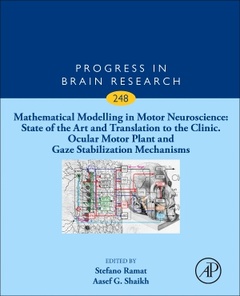Mathematical Modelling in Motor Neuroscience: State of the Art and Translation to the Clinic. Ocular Motor Plant and Gaze Stabilization Mechanisms

Mathematical Modelling in Motor Neuroscience: State of the Art and Translation to the Clinic. Ocular Motor Plant and Gaze Stabilization Mechanisms, Volume 248, the latest release in the Progress in Brain Research series, highlights new advances in the field, with this new volume presenting interesting chapters on a variety of topics, including Mathematical modeling in clinical and basic motor neuroscience, The math of medicine - the computational lessons learned from the human disease, Mathematical models - an extension of the clinician's mind, From differential equation to linear control systems: the study of the VOR, Closed lop and nonlinear systems, State-space equations and learning, Integrators and optimal control, and much more.
Section I - View of the field: Past present and future 1. Mathematical models and human disease Lance M. Optican and Elena Pretegiani 2. Mathematical models: An extension of the clinician's mind R. John Leigh and David S. Zee
Section II - Didactic: Modeling 3. Understanding the rotational vestibular ocular reflex: From differential equations to Laplace transforms Stefano Ramat 4. Integration of past and current visual information during eye movements in amblyopia Nicolas Deravet, Demet Yüksel, Jean-Jacques Orban de Xivry and Philippe Lefèvre 5. Mathematical models for dynamic, multisensory spatial orientation perception Torin K. Clark, Michael C. Newman, Faisal Karmali, Charles M. Oman and Daniel M. Merfeld
Section III - Didactic: Translational 6. Non-commutative, nonlinear, and non-analytic aspects of the ocular motor plant Joseph L. Demer 7. Clinical applications of control systems models: The neural integrators for eye movements Shirin Sadeghpour, David S. Zee and R. John Leigh
Section IV - Research: Plant and binocular control 8. Translation and eccentric rotation in ocular motor modeling Joseph L. Demer and Robert A. Clark 9. Extraocular muscles involved in convergence are innervated by an additional set of palisade endings that may differ in their excitability: A human study Karoline Lienbacher, Kathrin Sänger, Sebastian Strassburger, Oliver Ehrt, Günther Rudolph, Miriam Barnerssoi and Anja K.E. Horn 10. On the retinal correspondences across the binocular visual field Bernhard J.M. Hess 11. Motion and binocular disparity processing: Two sides of two different coins Christian Quaia, Edmond J FitzGibbon, Lance M Optican and Bruce G Cumming 12. Non-linearity in gaze holding: Experimental results and possible mechanisms Giovanni Bertolini, Fausto Romano, Nina Feddermann, Dominik Straumann, Alexander Andrea Tarnutzer and Stefano Ramat 13. Is infantile esotropia subcortical in origin? Michael C. Brodsky
Section V - Research: Vestibular, balance, and postural control 14. The influence of target distance on perceptual self-motion thresholds and the vestibulo-ocular reflex during interaural translation Susan King, Cyril Benoit and Faisal Karmali 15. Spatial orientation: Model-based approach to multi-sensory mechanisms Amir Kheradmand and Jorge Otero-Millan 16. Theoretical framework for "unexplained" dizziness in the elderly: The role of small vessel disease Diego Kaski, Heiko M. Rust, Richard Ibitoye, Qadeer Arshad, John H.J. Allum and Adolfo M. Bronstein 17. The functional head impulse test: Comparing gain and percentage of correct answers Maurizio Versino, Silvia Colnaghi, Giulia Corallo, Marco Mandalà and Stefano Ramat 18. Vestibular roll tilt thresholds partially mediate age-related effects on balance Sinem Balta Beylergil, Faisal Karmali, Wei Wang, Maria Carolina Bermúdez Rey and Daniel M. Merfeld 19. The velocity storage time constant balances between accuracy and precision Faisal Karmali 20. Toward dynamic modeling of visual-vestibular conflict detection Isabelle T. Garzorz and Paul R. MacNeilage 21. A conceptual model of the visual control of posture Adolfo M. Bronstein 22. Computational neurology of gravity perception involving semicircular canal dysfunction in unilateral vestibular lesions Stefan Glasauer, Marianne Dieterich and Thomas Brandt 23. Effect of motor and sensory noise in the control of upright standing Amel Cherif, Ian Loram and Jacopo Zenzeri 24. Model of optokinetic responses involving two different visual motion processing pathways Kenichiro Miura, Aya Takemura, Masakatsu Taki and Kenji Kawano
Postgraduates and researchers in the area of mathematical modelling, motor neuroscince and neuroscience in general.
- Provides the authority and expertise of leading contributors from an international board of authors
- Presents the latest release in the Progress in Brain Research series
- Includes the latest information on mathematical modeling in motor neuroscience
Date de parution : 06-2019
Ouvrage de 366 p.
19x23.3 cm



